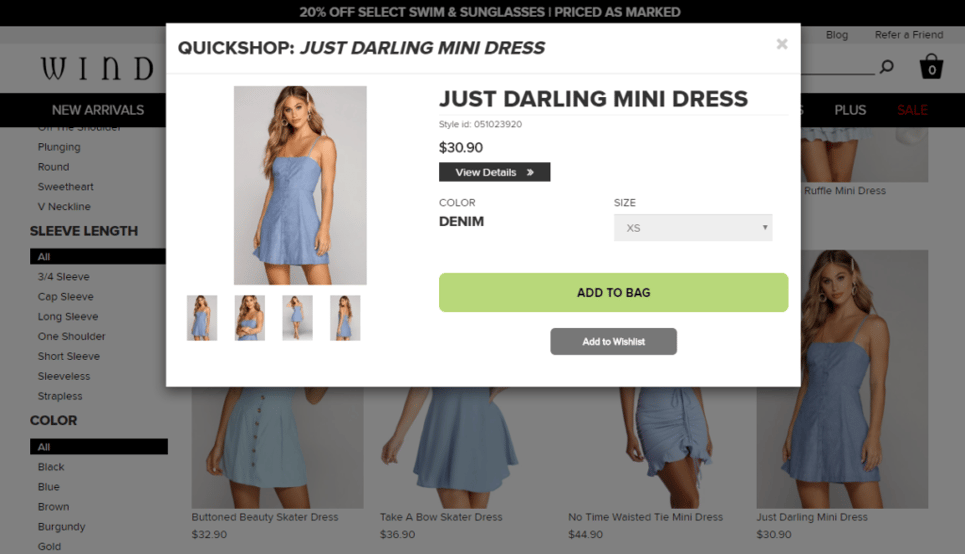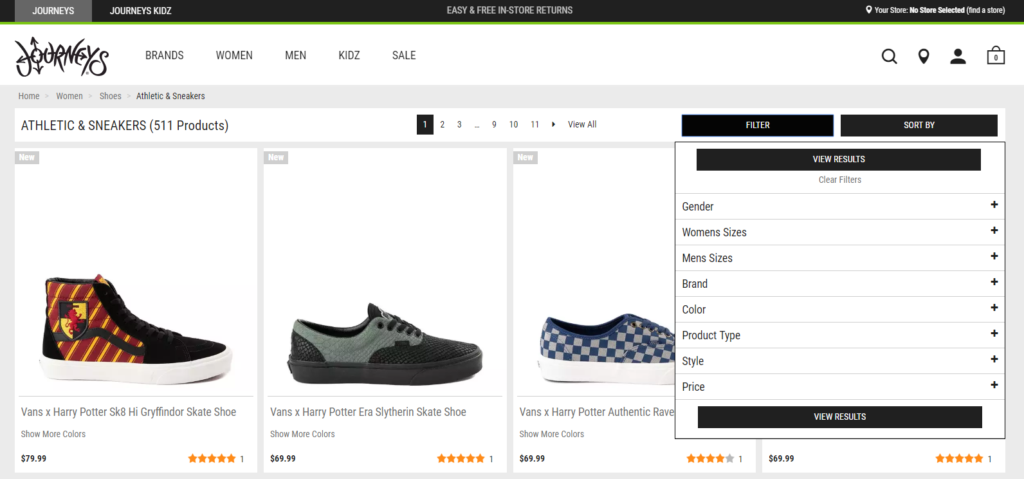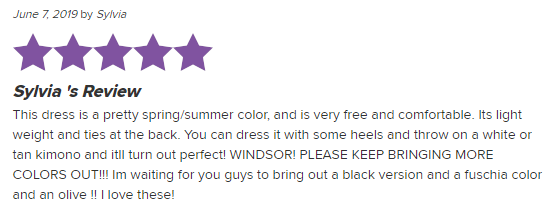
Increasing conversions on your eCommerce site creates a healthy bottom line and a loyal customer base. There are plenty of ways to increase eCommerce conversions, but most retailers are neglecting some of them. Run through this checklist to ensure you are not missing out on business:
1. Write clear, detailed product descriptions. Customers need to understand what they're buying or they won't add it to their cart. Keep your product descriptions concise, but make sure they capture all relevant information, such as product fit, key materials used, and any relevant instructions for use or care. Aim for 5-7 bullet points.
2. Following imaging best practices. Nothing lowers the perception of a brand's quality quicker than pixelated, text-overlaid product images. Take product photos against clean, solid backgrounds, and capture as many angles of the product as possible. Don't add text to your images, and make sure they are high quality and well-lit.
3. Use product videos. This can be particularly useful if you sell apparel. Seeing the fit of an item on a real, moving human can help customers envision how the product will look on themselves. This allows customers to 'try before they buy', which can also cut down on returns. Bonus points if you include models of different sizes to highlight the fit of the product.
4. Add quick shop to your site. Online shoppers are moving faster than ever, and they don't want to be bogged down by slow-loading sites or multiple clicks to get to their destination. Adding quick shop lets customers browse your site quickly, and find the products they want to buy more easily.
 Quick shop on Windsor.com helps increase conversions.
Quick shop on Windsor.com helps increase conversions.
5. Optimize your products for discovery. Make your product pages easy for consumers to find by using keywords in product descriptions and titles. Write in plain, concise language and optimize your pages with appropriate metadata. Not sure if your pages are optimized? Schedule a free site analysis and get a report with actionable insights to increase conversions.
6. Incorporate cross-selling and upselling. Using resources like 4-Tell's Smart Commerce platform, you can make personalized recommendations to customers based on items that they add to their cart. You can suggest additional items that pair well with their purchase, or upsell them on pricier items that fit their tastes.
7. Create personalized category landing pages. The more relevant the content on your site is to your customer, the more likely they are to convert. Creating personalized category landing pages allows you to address different segments of your target demographic, and directly recommend products to them.
8. Enable clear sorting/filtering. Allowing customers to filter their searches by an extensive list of product attributes helps create a more seamless path to checkout. Additionally, sorting options like 'Price Low to High' and 'Best Sellers' allow customers to shop the way they want, making them more likely to convert.
9. Let customers check out as guests. Nothing creates more friction at checkout than forcing a customer to create an account and submit multiple pieces of personal data before making a purchase. Streamline checkout by allowing shoppers to check out as guests. You can capture account sign-ups in a post-purchase email or through a loyalty program incentive.
10. Make 'Checkout' and 'Add to Cart' buttons highly visible. Test placement, size, and color. This seemingly small portion of the product page is incredibly important. If customers cannot find these buttons quickly, the likelihood of them converting decreases exponentially. Certain button colors and placement options can actually significantly increase conversions. Perform A/B testing to see what formula works for your site.
11. Always display shopping cart contents with a clear path to view it. Allow your customers to hover over the shopping cart and view its contents without having to click to a separate page. Make the cart easily clickable and clearly displayed at the top of the page navigation.
12. Write a clear return policy. 67% of shoppers will read a brand's return policy before making a purchase online. Make your return policy easy to find in the site navigation, and be sure to address a wide range of FAQ's in easy-to-understand terms (ex. 'Which shipping carriers can I use to return my items?').
13. Create an Online Returns portal. Giving your customers an easy way to complete returns, without needing the help of a customer service representative, can make the customer experience that much more seamless. No one wants to talk to a real person if they can help it, and an automated returns process can improve the customer experience.
14. Consider offering free shipping. According to the NRF, 75% of US consumers expect free shipping when shopping online. Amazon has set the industry standard with shipping times and free Prime shipping, and customers have raised their expectations. Retailers will be expected to deliver in order to compete.
15. Make the site search box visible across the entire site. This is a simple one. Make sure customers can find what they're looking for, no matter where they are on your site, especially the home page.
16. Add category and search filters. Without this feature, customers have a harder time finding what they're looking for, and it puts a heavier load on merchandisers, who have to come up with more categories to replace the missing filters. Consider adding text in the search box itself that disappears as a customer clicks into it. Options like 'I'm looking for...' or 'bathing suits, hiking boots, red boots' provide examples of how customers can search, guiding their search experience to help them find what they need.
 Product filters on Journeys.com guide customers on the path to checkout.
Product filters on Journeys.com guide customers on the path to checkout.
17. Add misspellings, synonyms, and alternate phrases into site search. Leave room for the human element of search. Customers won't always type in the exact right phrase, spelled correctly, to return the search result they need. Build in a back-up plan with alternate options to aid in the search process.
18. Enable multiple forms of payment. Limiting forms of payment means consumers can't shop they way they want to. Enabling payment options Like Apple Pay or Google Pay give customers flexibility, and can increase conversions.
19. Start selling on marketplaces. In the Age of Amazon, customers are increasingly looking to marketplaces to shop. Selling in marketplaces like Amazon and eBay can help increase your online sales and contribute to a healthy bottom line. For information on how to break into selling on Amazon, check out our whitepaper, the Retailer's Ultimate Guide to Selling on Amazon.
20. Create optimized marketplace listings. If you decide to enter into marketplaces, make sure you are optimizing your product listings, the same way you optimize your product pages on your own site. Follow these principles to determine how to list your products.
21. Comply with marketplace guidelines. Marketplaces like Amazon have extensive guidelines for sellers to follow. Ensure you do not get your product listings taken down by complying with these regulations.
22. Perform user testing. Test your entire customer experience on the path to checkout, including every button, dropdown, and pop-up. Services like those provided by User Testing can streamline the testing process and provide valuable customer insights to improve conversions.
23. Put mobile first. Make sure your customers can access the information they need anywhere, even in-store on a mobile device. Make sure product ratings and reviews are visible on mobile, allow for mobile payment options like Apple Pay, and create mobile responsive pages. With 200 million mobile shoppers in the US, you can't afford to alienate this massive population of consumers.
24. Make sure your site passes the thumb zone test. Consider if your mobile customers have to put in more effort than they'd like, in order to browse your site and checkout. The thumb zone is the most comfortable area for touch with one hand, so key CTA's and buttons should fall in that zone.
25. Incorporate mobile into your marketing strategy. Not only should your site be optimized for mobile, but your marketing efforts should be as well. Optimize your emails, your social media campaigns, and any other outreach that you do. Target customers on apps and with SMS. Reaching customers where they already are often means getting in front of them on their smallest screens.
26. Optimize your site for speed. Most mobile users will click away if a site takes more than 3 seconds to load. And if a page does not garner interest in less than 15 seconds, most people will leave. There are plenty of ways to increase site speed, including optimizing your images and partnering with a top-notch CDN provider. Check out more optimization tips on Moz.
27. Understand your target market/demographic. This should go without saying, but often retailers can forget to put the customer at the heart of everything they do. Build your site for the end user, and keep their needs and desires at the forefront of your strategy.
28. If it makes sense, partner with influencers. Influencer marketing has proven to be a valuable resource for many brands. Not sure how to implement it in your own business? Check out this comprehensive guide to eCommerce Influencer Marketing.
 Windsor's social gallery highlights influencer posts.
Windsor's social gallery highlights influencer posts.
29. Meet customers where they are. Target your customers where they already are. If your target demographic spends most of their time on Instagram and YouTube, partner with influencers or launch marketing campaigns on those channels. Likewise, if your customers largely shop on mobile, make sure your site is mobile-optimized for those users.
30. Enable social selling. Making your social media posts shoppable using services like Curalate's Like2Buy allow you to create an omnichannel experience. Customers are already on social media, so allowing them to shop on social can take friction out of the path to checkout.
31. Make the most of holidays. Use holidays to run marketing promotions and sales. Don't lose out on conversions during key times like Black Friday and Cyber Monday because your site is not optimized to handle increased traffic.
32. Refresh your email marketing. Email has one of the highest conversion rates when it comes to promotional content, but a strong email marketing strategy doesn't come easily. Make sure your emails are creative, with emotional or urgent subject lines, and personalized content. According to Experian, personalized emails deliver 6x higher transaction rates. Additionally, make sure your email marketing is optimized for mobile devices.
33. Add ratings and reviews on your site. 92% of customers read reviews when shopping online, and having product reviews on your site can increase conversions by 178%. Reviews provide social proof that give shoppers the confidence they need to make a purchase. Reviews platforms like Revere make implementation quick, so you can start capturing customer sentiment almost immediately.
 A review on Windsor.com with customized branded hearts.
A review on Windsor.com with customized branded hearts.
34. Add Heartbeat to your site. Revere's Heartbeat feature allows shoppers to 'heart' products on your site without having to sign in or create an account. This frictionless feedback gives retailers an idea of which products are most popular, and can provide valuable insights to improve conversions. For example, if a certain product has a large number of hearts but low sales, that may be an indication that the product is priced too high.
35. Create an errors strategy. Sometimes your site doesn't work the way it should. Don't lose conversions because of site errors. Make sure you are continually testing your site to find errors and implement a strategy to properly reroute customers.
36. Include BOPIS and Shop by Store. Incorporating Buy Online Pick Up in Store gives customers greater flexibility when shopping, and reduces turnaround times for them to get their products. Additionally, Shop by Store allows customers to see where products are located ahead of time, attracting more visitors to your site as well as brick-and-mortar locations.
37. Tighten up your fulfillment strategy. Outsourcing your fulfillment is just one way to streamline your back-end processes and deliver a better experience for your customers. Consider where else you can improve fulfillment efficiencies to deliver products faster and cut costs for your customers.
38. Consider fulfilling from store. Enable customers to buy online and pick up in store, ship from store, or offer one-hour pickup fulfillment. Check out tips on how to implement this strategy, from our partners at Deposco.
39. Update your training. To create an omnichannel customer experience, you will need to create a seamless connection between online and brick-and-mortar stores. For example, ensuring your store employees know how to look up out-of-stock products online, and customer service representatives know how to address basic user issues on your website allows customers to shop without friction.
40. Include social media training for customer service. With the rise of social selling and more customers finding your products through social media, social media training has become increasingly important for your customer service team. They should know how to respond to direct messages from your social media channels, as well as address any issues that may come out of social media (for example, complaints about defective products that may be posted to social).
41. Create an omnichannel experience. True omnichannel eCommerce involves creating a seamless customer experience across all channels and customer touchpoints, without friction. Customer should be able to shop where they want, when they want. This involves optimizing your site for mobile, bridging gaps between your online and brick-and-mortar stores, and building your business with the customer in mind. Read more about how to achieve omnichannel commerce here.
42. Send abandoned cart emails. According to SaleCycle, 75.6% of people will add products to their carts without ever completing a purchase. Targeting this segment of your site visitors is crucial to improving conversions. Consider sending abandoned cart emails like these examples to re-capture that traffic and return customers to your site.
43. Implement a loyalty program. Loyalty programs can improve customer satisfaction and encourage repeat purchases. To encourage loyalty program enrollment, place the CTA as close to checkout as possible, and consider offering a value-based incentive like free shipping which can be immediately redeemed at checkout.
44. Offer limited time coupon codes. Coupon codes and flash sales can be implemented by your eCommerce team, or by your platform vendor. They draw in new traffic to your site because of the urgency they create. Virid implemented flash sale capabilities on Windsor's site, increasing conversions. You can also include coupon incentives as part of your loyalty program offering.
45. Display a support phone number prominently. Customers want to know that they can contact someone immediately if they run into an issue when shopping. Retailers are expected to offer 24/7 support, so highlighting contact information lets customers know that you will be there for them.
 Current Boutique customers always have a direct line to customer service.
Current Boutique customers always have a direct line to customer service.
46. Implement chatbots. Along with a standard support number and email address, customers want to be able to get in touch with customer service immediately when they have an issue. Chatbots can field some customer service requests, and reduce some of the workload of those teams. If a customer can get their question or issue addressed quickly, they can go back to shopping and making a purchase.
47. Follow all compliance regulations. In a post-GDPR era, retailers are under increased scrutiny to comply with new regulations. Article 11, updates from the Supreme Court tax ruling, along with WCAG and PCI compliance are crucial for retailers to pay attention to. If your current team is not equipped to achieve compliance, contact Virid to see how we can help.
48. Let customers know their data is safe. Partnering with a vendor like Kount or Visa CyberSource ensures that financial data is safe from fraud, giving customers the confidence to shop your site.
49. Get an SSL certification. An SSL certification authenticates the identity of a website, and also encrypts any transmitting data. This is a given for legitimate business sites and can improve customer trust in your brand.
50. Get a free site audit to identify pain points. One of the quickest ways to understand where your site could be optimized for conversions is to set up a free consultation with an eCommerce expert. At Virid, we regularly perform free site audits to help retailers identify opportunities on their site, from SEO to UX, all delivered in one comprehensive report. Sign up for a site audit here.
51. Utilize Google Analytics to understand consumer behavior. Track metrics like bounce rate, exit rate, and average session duration. This will give you a clear picture of what is happening to your incoming site traffic, as well as which pages need to be optimized to increase conversions.
52. Choose technology partners wisely. Your site is only as strong as the technology behind it. Make sure you are working with the right eCommerce partners who will support your business goals. And before signing any contracts, make sure you are asking vendors these questions. If you're not sure which vendors are right for your business, give Virid a call. We offer full tech stack reviews for your eCommerce business.
[sf_modal header="First, tell us a bit about yourself:" link_type="button" link_text="Modal link" btn_colour="accent" btn_type="standard" btn_size="large" btn_icon="ss-star" btn_text="Optimize Your eCommerce Site "]
[/sf_modal]

